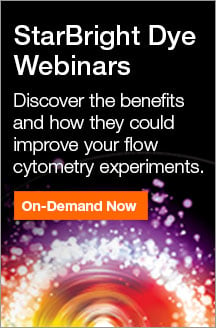StarBright Dye Publications
StarBright™ Dyes are novel dyes for flow cytometry designed to have superior brightness, narrow excitation and emission characteristics, ease of use, and stability. Conjugated to highly cited immunology antibodies, the StarBright Dyes range includes dyes excited by the ultraviolet, violet, blue, yellow, and red lasers suitable for use on all cell sorters, cell analyzers, and spectral instruments with the correct lasers and filters.
Peer Reviewed Publications
Here, we have collated all the latest publications citing the use of StarBright Dye conjugated antibodies so you can see how they perform in your hands.
-
Ferreira et al (2023) Atypical B cells and impaired SARS-CoV-2 neutralization following heterologous vaccination in the elderly Cell Reports 42,112991
Ferreira et al investigated the effect of age on immune response to SARS-CoV-2 vaccination. Multiparameter flow cytometry and single cell RNA sequencing was used to compare the immune response in individuals below 70 and 70 years or older. In older individuals it was found that despite similar levels of spike antibody IgG, there was a reduction in neutralizing antibody potency when receiving a third vaccine dose in addition to sub optimal boosting of spike-specific T cell responses, most markedly for the IL-2 response.
-
Roca CP et al. (2023) A cross entropy test allows quantitative statistical comparison of t-SNE and UMAP representations. Cell Reports Methods 3,100390~
Roca et al develop and validate the cross entropy test for robust comparison of dimensionality-reduced datasets in flow cytometry, mass cytometry, and single-cell sequencing, allowing statistical significance assessment and quantification of differences.
-
Tucker N et al. (2023). Bovine blood and milk T-cell subsets in distinct states of activation and differentiation during subclinical Staphylococcus aureus mastitis. J Reprod Immunol 156, 103826
This study investigates the differences in T cell populations in bovine blood and milk samples with chronic Staphylococcus aureus infections using a complex flow cytometry panel enabling detection of 15 separate T cell subsets.
-
Zheng W et al. (2023). Mycobacterium tuberculosis resides in lysosome-poor monocyte-derived lung cells during persistent infection. bioRxiv 524758
In this recent study, Zheng et al determined that after T cell responses have developed, CD11clo monocyte derived lung cells, termed MNC1 (mononuclear cell subset 1), harbor more live Mycobacterium tuberculosis compared to alveolar macrophages (AM), neutrophils, and less permissive CD11chi MNC2. A panel of antibodies, against CD11b, CD11c, Ly6G, Ly6C, I-A/I-E, Siglec F, and F4/80 StarBright Violet 570 (MCA497SBV570), was used to identify the different lung myeloid subsets using flow cytometry.
-
Whyte CE et al. (2022). Do more with less: improving high parameter cytometry through overnight staining. Current Protocols 2, e589
Here, Whyte et al demonstrate how increasing antibody incubation times can lead to substantial improvements in sensitivity, maintaining specificity, and reducing background, while also significantly reducing the costs of high-parameter cytometry panels.
Resources and Support
In addition to the publications listed here, you can find StarBright resources as well as a comprehensive set of general flow cytometry resources for self-help. Furthermore, our expert technical support are able to answer any queries including panel designing.




